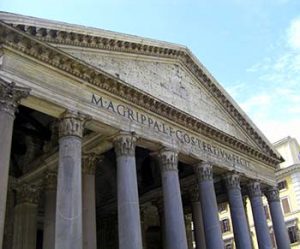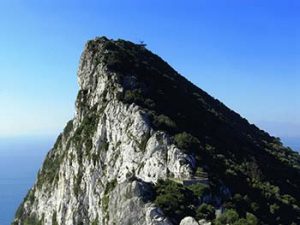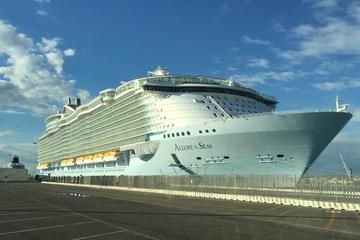
Spain, Italy & Greece
by Matthew Adams
The Mediterranean has a variety of intriguing historic destinations in Spain, Italy and Greece. One way you can visit some of those fascinating historical sites is via a cruise. Cruise ships usually stop at ports in Italy, Spain, France and Greece from which you visit some of the world’s greatest museums and historical architecture. This is a Crown Princess cruise I did to see some of the finest historic destinations.
Barcelona
Barcelona, in Catalonia, was the first stopping port. This is a historically significant city in its own right that includes some astonishing architecture. Its most notable architectural landmark is the Sagrada Familia, designed by Gaudi, that includes eight spires which will increase to 18 when construction of the church is complete.
I never went in the Sagrada Familia on my trip, but instead went to the Montserrat Monastery. This is a Benedictine abbey at the summit of the Montserrat mountain. As the mountain rises about 1,200 meters, it’s worth a trip just for the magnificent views alone. There you can also hike the Montserrat nature park that includes numerous hiking trails.
Pisa and Florence
 On another stop I visited Pisa with a coach excursion. There I visited the Cathedral Square, a UNESCO heritage site, that is one of the greatest architectural complexes in Europe. That is largely due to the Leaning Tower of Pisa, which is a 183 foot tower with a slight lean of about four degrees. I briefly went in the Duomo cathedral, a masterpiece of Romesque architecture, before returning to the coach. However, the tour gave me little more than 30 minutes in Pisa.
On another stop I visited Pisa with a coach excursion. There I visited the Cathedral Square, a UNESCO heritage site, that is one of the greatest architectural complexes in Europe. That is largely due to the Leaning Tower of Pisa, which is a 183 foot tower with a slight lean of about four degrees. I briefly went in the Duomo cathedral, a masterpiece of Romesque architecture, before returning to the coach. However, the tour gave me little more than 30 minutes in Pisa.
Florence was the next stop on the tour. The historical significance of Florence lies in the Renaissance era, otherwise a cultural rebirth, that inspired a new breed of art and architecture in the city. So it’s not surprising that the Historic Center of Florence is another UNESCO heritage site.
I got a little more time in Florence than Pisa. So I went inside Florence Cathedral that is an effective blend of Italian Gothic, Renaissance and Gothic Revival architecture. The most striking aspect of this cathedral is its huge dome, which is the largest masonry dome ever constructed. I also visited the Ponte Vecchio bridge across the River Arno, which is another of Florence’s landmarks. The bridge retains some of its towers originally built as defensive structures.
Rome
 As the capital of an empire that once dominated Europe, Rome has obvious historical significance. The city has preserved some of the finest buildings from the former empire. I took some snapshots of the Colosseum on my trip. I also went to the Pantheon, a remarkably preserved temple that has intriguing architecture. The temple has a coffered concrete dome with an oculus, or central opening, at its summit through which sunlight beams through. With that the Pantheon might have effectively been one giant sundial.
As the capital of an empire that once dominated Europe, Rome has obvious historical significance. The city has preserved some of the finest buildings from the former empire. I took some snapshots of the Colosseum on my trip. I also went to the Pantheon, a remarkably preserved temple that has intriguing architecture. The temple has a coffered concrete dome with an oculus, or central opening, at its summit through which sunlight beams through. With that the Pantheon might have effectively been one giant sundial.
The next stop for the coach was the Vatican. The Vatican has been a separate city-state since fascist Italy established the Lateran Treaty. The Vatican Museums are among the largest in the world, and they include some of the most priceless Renaissance art. The museums showcase a multitude of sculptures, paintings, stone tablets and archeological relics dug up from excavations. Furthermore, visitors can also check out the St. Peter’s Basilica church at St Peter’s Square that also has fabulous Renaissance architecture.
I had a ticket specifically for the Sistine Chapel. That is another masterpiece of Renaissance art with its finely painted ceiling and numerous frescoes that decorate the interior. Finding the Sistine Chapel in the Vatican Museums is not easy, and you can get lost within the maze of corridors. A day at the Vatican would never be enough to effectively explore the immense museum collections. Nevertheless, I eventually found the chapel that was something to behold.
Gibraltar
 Finally, the Crown Princess stopped at Gibraltar. This U.K. overseas territory is most notable for the Rock of Gibraltar, which is a limestone rock that rises about 1,398 feet. As the gateway to the Mediterranean, Gibraltar was a strategically vital outpost of the British Empire. Consequently, the British army dug a series of tunnels through the rock where it could store armaments and munitions. The tunnels also protected troops from coastal and aerial bombardments. Britain dug the most extensive Gibraltar tunnels during the 1940s that were expansive enough to accommodate a garrison of 16,000 troops.
Finally, the Crown Princess stopped at Gibraltar. This U.K. overseas territory is most notable for the Rock of Gibraltar, which is a limestone rock that rises about 1,398 feet. As the gateway to the Mediterranean, Gibraltar was a strategically vital outpost of the British Empire. Consequently, the British army dug a series of tunnels through the rock where it could store armaments and munitions. The tunnels also protected troops from coastal and aerial bombardments. Britain dug the most extensive Gibraltar tunnels during the 1940s that were expansive enough to accommodate a garrison of 16,000 troops.
I made the trip up the rock for the terrific Mediterranean views. I also entered the entrance of the tunnels of Gibraltar, which are otherwise the Great Siege Tunnels. In addition, I stopped at St. Michael’s Cave, which is a network of limestone caves. There I went inside the Cathedral Cave that includes an auditorium for concerts and drama productions.
Thereafter, I returned to Blighty. What better way to ‘travel through history’ than a European cruise? You can visit many of Europe’s finest historic venues in Italy, Spain or Greece with coach excursions from cruise ports. The only disadvantage is that some coach trips might only give you a very limited time period at a destination.
If You Go:
Pantheon
Vatican Museums
Leaning Tower of Pisa
Great Siege Tunnels
St. Michael’s Cave
Montserrat

Pisa and Florence Private Day Trip from Livorno
About the author:
Matthew is a freelancer who has produced a variety of articles for various publications and websites such as Swing Golf Magazine, TripAdvisor, Naval History, Artilleryman, dotTech, Bright Hub, Coed Magazine the Washington Post and Vagabundo Travel. Matthew is also the author of Battles of the Pacific War 1941 – 1945. Check out the book’s blog at battlesofthepacificwar.blogspot.co.uk.
All photos are by Matthew Adams:
The Benedictine abbey at Montserrat
The Duomo and Leaning Tower of Pisa at Pisa
The Pantheon in Rome
A snapshot of the Rock of Gibraltar at Gibraltar




Leave a Reply
You must be logged in to post a comment.